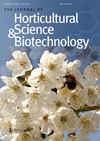可溶性碳水化合物与切花月季‘黛丽拉’和‘索尼娅’的花期变化
IF 2.1
4区 农林科学
Q2 HORTICULTURE
Journal of Horticultural Science & Biotechnology
Pub Date : 2005-01-01
DOI:10.1080/14620316.2005.11511930
引用次数: 17
摘要
蔷薇(Rosa hybrida L. cv.)采收后特征。以长寿品种黛丽拉(Delilah)为对照。“索尼娅”,短命栽培品种。“黛丽拉”的花瓶寿命为10.6天,而“索尼娅”的花瓶寿命为5.6天。“索尼娅”的花瓣放在水中不能完全反射,呈现蓝色。而蔗糖加8-羟基喹啉硫酸盐(HQS)处理能显著促进花瓣反射,抑制蓝化。相比之下,放在水中的“黛丽拉”花完全反射,没有出现蓝色。在两个品种中,控制处理的茎段水力导度在收获后迅速下降。HQS抑制了这种下降。在整个实验期间,“Delilah”花瓣中葡萄糖、果糖和蔗糖的浓度比“Sonia”高得多。“索尼娅”和“黛丽拉”在茎和叶的可溶性碳水化合物浓度方面没有差异。“索尼娅”花瓣中的淀粉含量高于“黛丽拉”。本文章由计算机程序翻译,如有差异,请以英文原文为准。
Soluble carbohydrates and variation in vase-life of cut rose cultivars ‘Delilah’ and ‘Sonia’
SummaryPost-harvest characteristics of Rosa hybrida L. cv. ‘Delilah’, a long-lived cultivar, were compared with those of cv. ‘Sonia’, a short-lived cultivar. The vase-life of ‘Delilah’ was 10.6 d whereas that of ‘Sonia’ was 5.6 d. Petals of ‘Sonia’ flowers kept in water did not reflect fully and showed blueing. However, treatment with sucrose plus 8-hydroxyquinoline sulphate (HQS) markedly promoted petal reflection and inhibited blueing. In contrast, ‘Delilah’ flowers kept in water reflected fully and did not show blueing. In both cultivars, hydraulic conductance of stem segments in the control treatment decreased rapidly after harvest. Treatment with HQS suppressed this decrease. Concentrations of glucose, fructose and sucrose in petals of ‘Delilah’ were much higher throughout the experimental period than those of ‘Sonia’. There was no difference between ‘Sonia’ and ‘Delilah’ in soluble carbohydrate concentrations in stems and leaves. Starch concentration in petals of ‘Sonia’ was higher than in ‘Delilah’...
求助全文
通过发布文献求助,成功后即可免费获取论文全文。
去求助
来源期刊
CiteScore
3.90
自引率
5.30%
发文量
67
审稿时长
3 months
期刊介绍:
The Journal of Horticultural Science and Biotechnology is an international, peer-reviewed journal, which publishes original research contributions into the production, improvement and utilisation of horticultural crops. It aims to provide scientific knowledge of interest to those engaged in scientific research and the practice of horticulture. The scope of the journal includes studies on fruit and other perennial crops, vegetables and ornamentals grown in temperate or tropical regions and their use in commercial, amenity or urban horticulture. Papers, including reviews, that give new insights into plant and crop growth, yield, quality and response to the environment, are welcome, including those arising from technological innovation and developments in crop genome sequencing and other biotechnological advances.

 求助内容:
求助内容: 应助结果提醒方式:
应助结果提醒方式:


